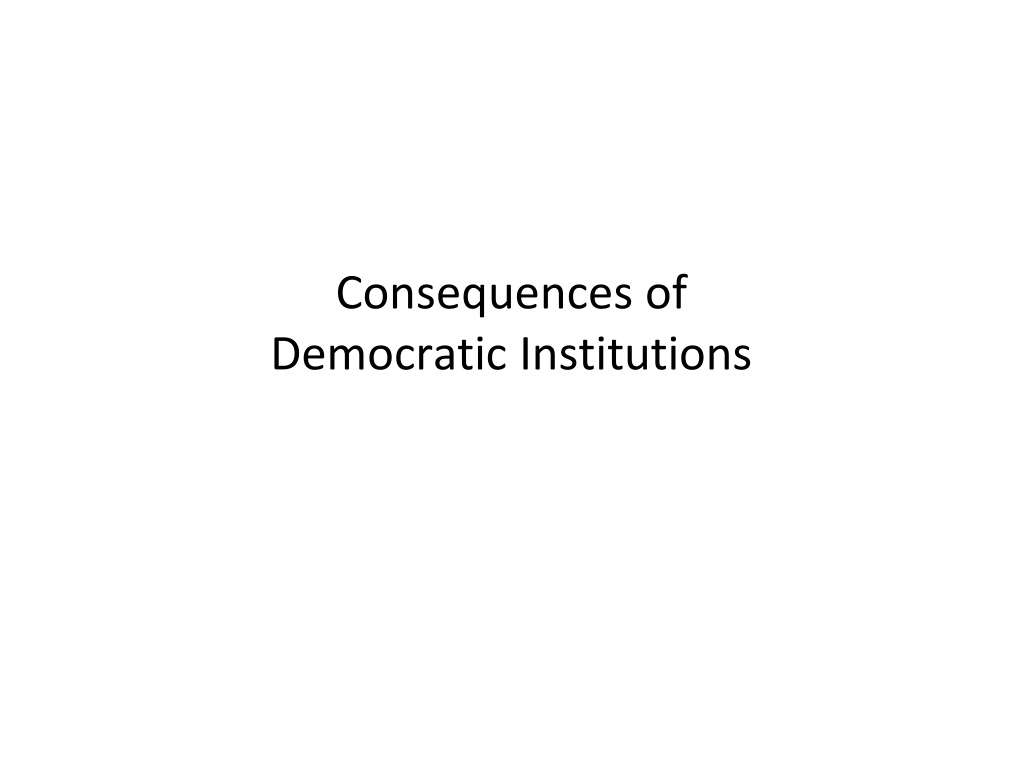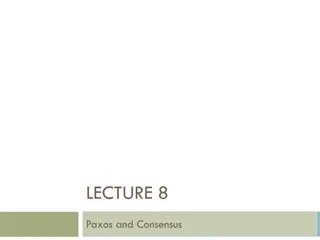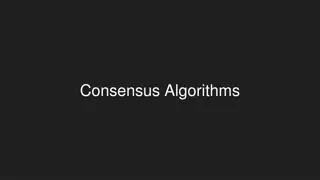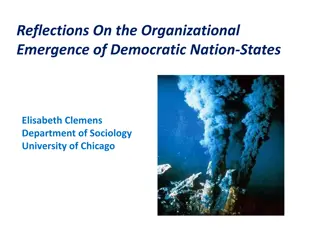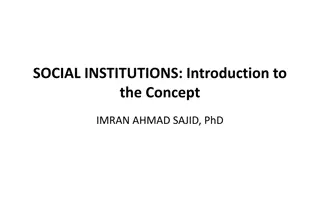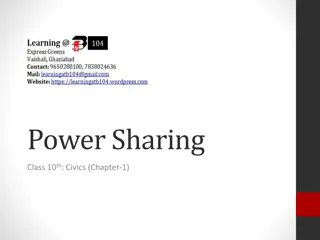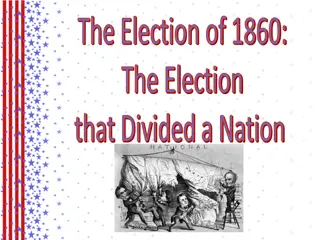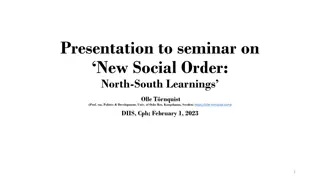Perspectives on Democratic Institutions: Majoritarian vs. Consensus Vision
Democratic institutions have consequential impacts on political representation, economic policy, ethnic conflict, and democratic survival. Two distinct visions, majoritarian and consensus, shape the distribution of power in governance. The majoritarian vision concentrates power in the hands of the majority, with an emphasis on accountability through elections. In contrast, the consensus vision prioritizes inclusivity and representation across diverse social groups, aiming to mirror society in legislative bodies. These contrasting viewpoints influence decision-making processes and perceptions of legitimacy within democratic systems.
- Democratic institutions
- Majoritarian vs. Consensus
- Governance impact
- Political representation
- Conflict resolution
Download Presentation

Please find below an Image/Link to download the presentation.
The content on the website is provided AS IS for your information and personal use only. It may not be sold, licensed, or shared on other websites without obtaining consent from the author. Download presentation by click this link. If you encounter any issues during the download, it is possible that the publisher has removed the file from their server.
E N D
Presentation Transcript
Consequences of Democratic Institutions
Impact of democratic institutions: 1. Democracy and political representation 2. Economic Policy 3. Ethnic Conflict 4. Democratic Survival
Two different visions of democracy: 1. Majoritarian vision: Concentrate power in the hands of the majority. 2. Consensus vision: Disperse power to as many people as possible.
Majoritarian vision of democracy Two alternative teams of politicians compete for the support of voters. The team selected by a majority of the voters is given unfettered control over policy. The winning team implements the policies it ran on during the election campaign.
Majoritarian vision of democracy Citizens know which team is responsible for policy outcomes. They can use their evaluations of the policy record when deciding whether to reward or punish the incumbent in the following election. Citizens only get to exert influence at election time.
Majoritarian vision of democracy Power is concentrated in the hands of a single majority team of politicians. The involvement of the minority in the policy-making process is considered illegitimate.
Majoritarian vision of democracy Power is shared over time as different majorities compete and alternate in power. Self-imposed constraints the winning team must make compromises and exercise self-control so that the minority doesn t withdraw from participating in democratic institutions and engage in violence.
Consensus vision of democracy During elections, citizens are to choose representatives from as wide a range of social groups as possible. Elections should produce a legislature that s a miniature reflection of society as a whole. Elections aren t designed to serve as some sort of referendum on the set of policies implemented by the government.
Consensus vision of democracy Representatives are agents who bargain on behalf of the citizenry. Citizens exert influence over the policy making process between elections through the ongoing bargaining of their elected representatives.
Consensus vision of democracy Citizens with majority preferences don t have a privileged status. All groups, including minorities, should have the power to influence policy in direct proportion to their electoral size. Power is to be shared not only over time but also at each moment in time.
Consensus vision of democracy An important objective is to prevent a tyranny of the majority. Constrained government must be compelledthrough an external system of checks and balances and the use of anti-majoritarian institutions.
Majoritarian democracies have few veto players and so its easier to change the status quo. Consensus democracies have many veto players and so it s harder to change the status quo. Which is better for protecting minorities?
Institutions and the Majoritarian-Consensus Dimension Institution Majoritarian Consensus Electoral system Majoritarian Proportional Party system Two parties Many parties Government type Single-party majority Coalition/minority Federalism Unitary Federal Bicameralism Unicameral Bicameral Constitutionalism Legislative supremacy constitution Higherlaw constitution Note: There are two sets of institutions the top set and the bottom set. The institutions in each set are causally related.
Political Representation What do these different visions of democracy mean for political representation?
Formalistic representation has to do with how representatives are authorized and held accountable. Descriptive representation addresses the extent to which representatives resemble and stand for their constituents. Symbolic representation focuses on the symbolic ways that representatives stand for the citizens. Substantive representation emphasizes how representatives act for the people and promote their interests.
Formalistic Representation Authorization and accountability are treated differently in the majoritarian and consensus visions of democracy.
Authorization In majoritarian systems, it s majority support that authorizes political actors to wield power. In consensus systems, power is to be distributed among political actors in direct proportion to their electoral size. The two systems don t always live up to these ideals in practice.
Accountabilityrefers to the extent to which its possible for voters to sanction parties for the actions they take while in office. Retrospective voting occurs when voters look at the past performance of incumbent parties to decide how to vote in the current election. Accountability tends to be high in majoritarian systems and low in consensus systems.
Clarity of responsibility is the extent to which voters can identify exactly who s responsible for the policies that are implemented. Clarity of responsibility is a necessary condition for accountability. Clarity of responsibility tends to be high in majoritarian systems and low in consensus systems.
Substantive Representation Substantive representation occurs when representatives take actions in line with the substantive and ideological interests of those they represent. Substantive representation can be evaluated in terms of ideological congruence or ideological responsiveness.
Ideological congruence has to do with the extent to which the actions of the representatives are in line with the interests of the people at a fixed point in time. Ideological responsiveness has to do with how representatives change their behavior to become more congruent with the interests of the people over time.
Ideological Congruence and Responsiveness (a) R C (b) R C (c) R C C
Majoritarian and consensus systems differ in how they think about ideological congruence. Majoritarian systems want congruence with the majority, usually represented by the preference of the median voter. Proportional systems want congruence with the full distribution of voter preferences.
Empirically, the ideological congruence of governments with their citizens is very similar in majoritarian and consensus systems.
Theoretically, majoritarian systems should exhibit higher levels of ideological responsiveness. The incentives and ability to be responsive should be higher in majoritarian systems. However, few empirical studies have examined this issue.
Descriptive Representation Descriptive representation has to do with whether representatives resemble and therefore stand for their constituents. It calls for representatives who share the same characteristics, such as race, gender, religion, and class, as those they represent. Descriptive representation is valued more highly in consensus democracies than in majoritarian democracies.
Two potential arguments for descriptive representation: 1. Descriptive representation is valuable in its own right it signals a policy of recognition and acceptance, and it promotes a sense of fairness and legitimacy. 2. Descriptive representation can be a pathway to improved substantive representation.
Critics of descriptive representation argue that it can promote group essentialism, the idea that all members of a group share an essential identity that only they can have and understand. Group essentialism can promote stereotyping that facilitates discrimination. It s often accompanied by the policing of group norms and the punishment of group members who break those norms. Group essentialism can be divisive and causes people to ignore the heterogeneity that exists within groups.
Descriptive representation of women The average level of women s legislative representation in the world in 2023 was 25.6%. The countries with the highest levels of women s representation are:
Descriptive representation of women The average level of women s legislative representation in the world in 2023 was 25.6%. The countries with the highest levels of women s representation are: Rwanda (61.3%), Cuba (55.7%), Nicaragua (51.7%), Andorra (50%), and Mexico (50%). The countries with the lowest levels of women s representation are:
Descriptive representation of women The average level of women s legislative representation in the world in 2023 was 25.6%. The countries with the highest levels of women s representation are: Rwanda (61.3%), Cuba (55.7%), Nicaragua (51.7%), Andorra (50%), and Mexico (50%). The countries with the lowest levels of women s representation are: Papua New Guinea (1.7%), Vanuatu (1.9%), Oman (2.3%), Kuwait (3.1%), and Nigeria (3.9%).
Gender distortions can arise in each stage of the political recruitment process. 1. Set of eligible candidates 2. Only some aspire to compete for office 3. Only some are nominated by a political party 4. Only some are elected
Most studies find that proportional electoral rules help the election of women candidates. There s mixed evidence as to whether open list or closed list PR systems are best.
Over the last two decades, gender quotas have played a significant role in increasing the share of women legislators around the world. Reserved legislative seats Legislated candidate quotas Voluntary political party quotas
Autocratic genderwashing Many dictatorships use reserved seats to guarantee legislative seats to female candidates. Including women in visible political roles can help authoritarian elites obtain international and domestic support. But the strategic use of women s descriptive representation also occurs in democracies.
Theres some evidence that the descriptive representation of women improves the substantive representation of women. However, the strength of the empirical evidence is contested.
Symbolic Representation Symbolic representation focuses on the symbolic ways that representatives stand for the citizens.
Symbolic representation constructs boundaries that allow us to see who and what is being represented. Symbolic representation challenges the notion that there are constituencies out there waiting to be represented. It suggests that representatives create constituencies for themselves to represent through the symbolic claims they make about their constituents.
If constituencies are constructed, then symbolic representation is a process by which certain groups or identities are deemed worthy of representationand others aren t. In addition to identifying who s worthy of representation, the constitutive process of symbolic representation also identifies who can appropriately represent particular groups.
Fiscal policy involves the manipulation of tax and spending decisions to accomplish governmental goals.
Political economy model. Economic policy is typically made by elected officials who may have goals other than stable growth. Economic policies tend to have distributional consequences.
What explains this cross-national variation in fiscal activity?
Economic and Cultural Determinants Total public fiscal activity is often interpreted as the size of government because it gives an indication of the ratio of total government economic activity to overall activity in the country. Wagner s Law states that the size of government grows as countries become more industrialized.
Meltzer-Richard Model Citizen preferences regarding fiscal policy depends on their level of income. The government taxes all individuals at the same rate. The government takes the tax revenue and divides it equally among all members of society.
